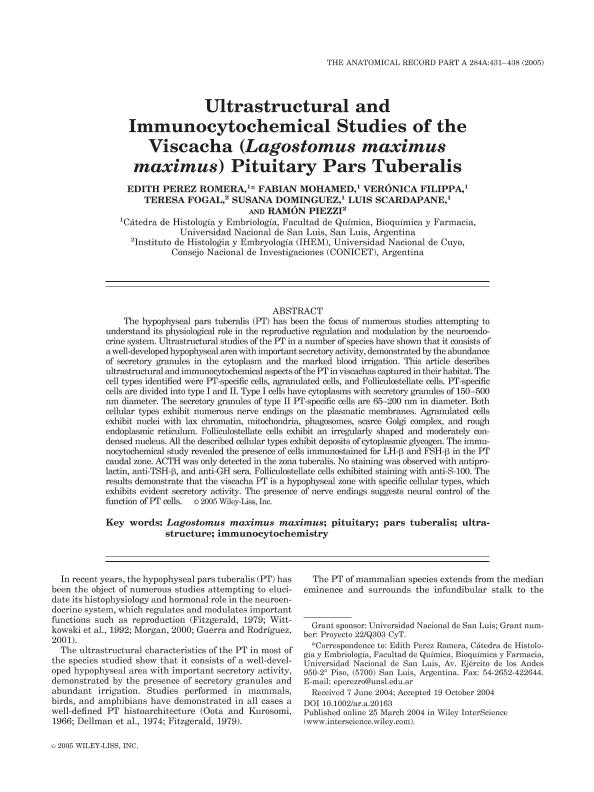Artículo
Ultrastructural and immunocytochemical studies of the Viscacha (Lagostomus maximus maximus) pituitary pars tuberalis
Perez Romera, Edith; Mohamed, Fabian Heber; Filippa, Veronica Palmira ; Fogal, Teresa Hilda
; Fogal, Teresa Hilda ; Dominguez, Susana; Scardapane, Luis Antonio; Piezzi, Ramon Salvador
; Dominguez, Susana; Scardapane, Luis Antonio; Piezzi, Ramon Salvador
 ; Fogal, Teresa Hilda
; Fogal, Teresa Hilda ; Dominguez, Susana; Scardapane, Luis Antonio; Piezzi, Ramon Salvador
; Dominguez, Susana; Scardapane, Luis Antonio; Piezzi, Ramon Salvador
Fecha de publicación:
05/2005
Editorial:
Wiley-liss, div John Wiley & Sons Inc.
Revista:
Anatomical Record
ISSN:
1552-4884
Idioma:
Inglés
Tipo de recurso:
Artículo publicado
Clasificación temática:
Resumen
The hypophyseal pars tuberalis (PT) has been the focus of numerous studies attempting to understand its physiological role in the reproductive regulation and modulation by the neuroendocrine system. Ultrastructural studies of the PT in a number of species have shown that it consists of a well-developed hypophyseal area with important secretory activity, demonstrated by the abundance of secretory granules in the cytoplasm and the marked blood irrigation. This article describes ultrastructural and immunocytochemical aspects of the PT in viscachas captured in their habitat. The cell types identified were PT-specific cells, agranulated cells, and Folliculostellate cells. PT-specific cells are divided into type I and II. Type I cells have cytoplasms with secretory granules of 150?500 nm diameter. The secretory granules of type II PT-specific cells are 65?200 nm in diameter. Both cellular types exhibit numerous nerve endings on the plasmatic membranes. Agranulated cells exhibit nuclei with lax chromatin, mitochondria, phagosomes, scarce Golgi complex, and rough endoplasmic reticulum. Folliculostellate cells exhibit an irregularly shaped and moderately condensed nucleus. All the described cellular types exhibit deposits of cytoplasmic glycogen. The immunocytochemical study revealed the presence of cells immunostained for LH- and FSH- in the PT caudal zone. ACTH was only detected in the zona tuberalis. No staining was observed with antiprolactin, anti-TSH-, and anti-GH sera. Folliculostellate cells exhibited staining with anti-S-100. The results demonstrate that the viscacha PT is a hypophyseal zone with specific cellular types, which exhibits evident secretory activity. The presence of nerve endings suggests neural control of the function of PT cells.
Archivos asociados
Licencia
Identificadores
Colecciones
Articulos(CCT - SAN LUIS)
Articulos de CTRO.CIENTIFICO TECNOL.CONICET - SAN LUIS
Articulos de CTRO.CIENTIFICO TECNOL.CONICET - SAN LUIS
Articulos(IHEM)
Articulos de INST. HISTOLOGIA Y EMBRIOLOGIA DE MEND DR.M.BURGOS
Articulos de INST. HISTOLOGIA Y EMBRIOLOGIA DE MEND DR.M.BURGOS
Citación
Perez Romera, Edith; Mohamed, Fabian Heber; Filippa, Veronica Palmira; Fogal, Teresa Hilda; Dominguez, Susana; et al.; Ultrastructural and immunocytochemical studies of the Viscacha (Lagostomus maximus maximus) pituitary pars tuberalis; Wiley-liss, div John Wiley & Sons Inc.; Anatomical Record; 284; 1; 5-2005; 431-438
Compartir
Altmétricas



